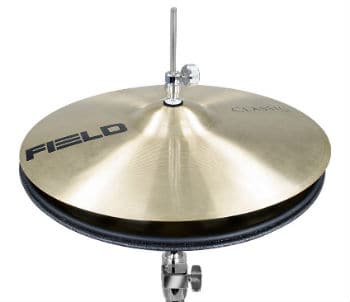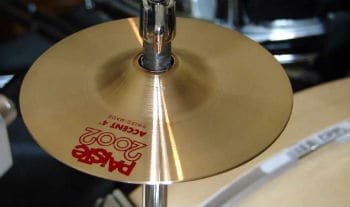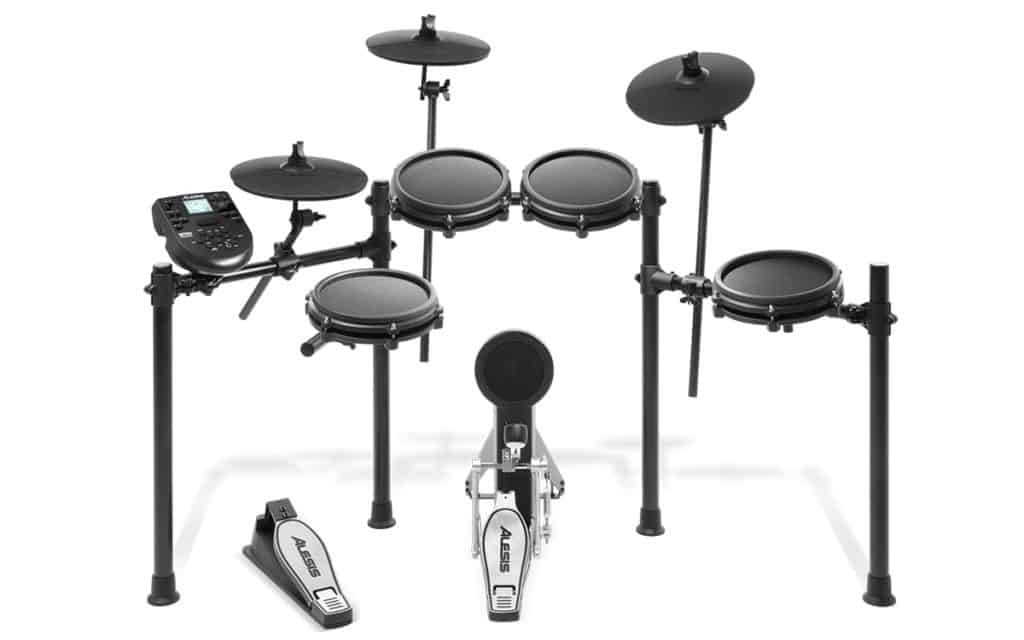Last Updated on November 2, 2021 by Danny
Most drummers tend to personalize and modify their drum kits, there are actually a few basic parts that are standard across most drum kits. If you are an aspiring drummer, here are the parts of a drum set that you should become familiar with.
The drum kit may be loosely divided into four parts:
- Shells: The toms and bass drum
- Breakables: Cymbals, snare drum, drumsticks, and drum throne
- Extensions: These are anything that is not part of a standard set, for example, cowbells and chimes.
- Hardware: Drum rack, cymbal stands, drum stands, and pedals
While the bass drum and toms are not changed but the sticks, cymbals, and snare drum are commonly replaced with each drummer’s own component. This is why these are known as breakables, as they are broken down and replaced after each band.
The drumset could look like a simple instrument that only consists of a few shells and cymbals for many people. From the giant bass drum to the tiny lugs that hold everything in place, there are dozens of parts that work together to make a working drum set.
A full drum set normally consists of four drums: a snare, bass, mounted tom (sometimes two mounted toms) and a floor tom. If you are beginner this is a standard configuration for you. As you progresses you can upgrade your kit with more parts.
While a three piece drum set consists of 3 main parts which are a bass drum, a 14″ diameter snare drum, 12″–14″ hi-hats, a single 12″ diameter hanging tom, 8″–9″ in depth, and a suspended cymbal, in the range of 14″–18″, both mounted on the bass drum.
Here are all Parts of a Drum Kit
In the below guide, we have used a five-piece drum set to explain what a kit does includes.
Bass Drum/Kick Drum

The bass drum is usually the biggest drum in a drum kit. It is also known as a kick drum as it is operated by the foot pedal which is attached to the hoop of the drum. It provides the basic foundation for the rhythm. The big size of the bass drum allows it to produce the lowest pitch in the kit and is usually used to provide the basic beat with simple pulse patterns. Muffling drums with pillows and other muffling material is a common practice that is used to reduce overtones and the overall volume of the drum.
A few drummers use multiple bass drums or a single bass drum with a double bass drum pedal. This technique of double bass drumming is crucial in multiple heavy metal styles. A double bass drum pedal allows a drummer to get double bass drumming with just a single bass drum, thus saving space and lowering the effort and time spent on setting the drums up. This makes them quite advantageous in both recording and gigging situations. But for recording, you also need the best bass drum mic stand.
There are 7 parts of a bass drum which are: Shell, batter head, resonant head, Turning bolt hoop(rim) rug, Lug, turning bolts, bass drum leg, and pipe clamps. There are so many sizes of bass drums available in the market but the most common of them is 20″ or 22″ in diameter.
If you want to learn how to tune a kick drum, check out our bass drum tuning guide.
Snare drum

The snare drum is usually considered to be the heart of any drum set, especially in rock genres. This is because it produces the backbeat. It is able to produce powerful regular accents and forms the backbone of many fills.
The shell of a snare drum is typically made from metal or wood and is usually shallower than the other rums. The sound of the snare is distinctive due to the stiff snare wires that are held in tension to the underside of the bottom drumhead. Each time these snare wires are held in tension, also known as engaged, they vibrate along with the upper drum head. This produces a snappy buzzing sound in addition to the typical sound of the batter head being stricken by the drum stick.
It is usually mounted with a 3-armed bracket placed on a snare drum stand. The stand can usually be adjusted to bring it to a height that is comfortable for the drummer. Drummers can have the snare either flat or slightly tilted towards them, based on their preference.
It consists of 7 parts which are: Shell, Head, Hoop, Turning Bolt, Lug, Snare, Strainer.
[amazon bestseller=”snare drum” order_items=”5″ template=”table” button_text=”Buy on Amazon”]Toms

Toms, formally called tom-tom drums, are the drums that aren’t snares and are played using drumsticks. Toms are typically the most numerous drum kit parts. They produce the majority of the solos and fills.
There are 4 different types of toms which are double-headed rack toms, floor toms, single-headed concert toms, and rototoms. Floor and Rack tom is part of a 5 piece drum set.
Tom-tom has 6 parts which are Shell, Head” class, Hoop (rim), turning bolt, Lug, rod clamp. Toms sound much deeper than a snare and can resonate for long periods of time.
Drum kit configurations are usually named based on the number of toms they possess, as the number of toms is the thing that usually varies with snare and bass drum being typically just one. Jazz drum kits usually have smaller tom shells of 10”,12”, and 14” sizes while rock drum kits have bigger ones of 12”,13”, and 16” sizes.
The floor tom is usually the biggest tom, thus allowing them to produce the lowest pitches among toms. However, they still have a higher pitch than that of a bass drum. It is called a floor tom as it is placed independently on its own legs.
[amazon bestseller=”tom tom drum” order_items=”5″ template=”table” button_text=”Buy on Amazon”]Cymbals
Even though we call them drum sets, cymbals play a role as important as drums in any kit. Cymbals have been in existence since the early Bronze Age and have been used prevalently in ancient Near East. This makes them the oldest idiophones to be used for music. Turkey and Turkish craftsmanship is deeply associated with cymbals. Zildjian has been making cymbals in turkey since 1623. Fun fact, Zildjian actually means cymbal smith.
A standard beginner cymbal pack consists of four cymbals: a crash, a ride, and two hi-hats. Some kits come with only three cymbals, with a single hybrid crash/ride rather than two segregate ones. Many drummers extend their range by including extra cash, an effect cymbal, a splash, or a combination of these.
[amazon bestseller=”cymbal pack” order_items=”5″ template=”table” button_text=”Buy on Amazon”]Hi-hat Cymbal

The hi-hat cymbals, or simply hats, are made up of two cymbals that are mounted to face each other on a pole. The pole has supporting legs that help keep the hollow support cylinder upright. The lower cymbal is fixed and does not move.
The upper cymbal is mounted onto a thin pole, using a clutch, which is then inserted into the hollow cymbal stand. This thin pole is then linked to the foot pedal. You can make sounds from the hi-hats by either striking the different parts of the cymbals with drumsticks or by simply opening and closing the cymbals using the foot pedal.
As the hi-hats can create rhythms with just the foot, drummers can use both the sticks on other cymbals for drums. You can also make different sounds by striking on the cymbal with the pedal depressed(open hi-hat) or pressed down(close hi-hat).
Take a lot at some of the best hi hat stand for the money
[amazon bestseller=”hi hat cymbal” order_items=”5″ template=”table” button_text=”Buy on Amazon”]Ride cymbal

The ride cymbal is the biggest of all cymbals. It is made of zinc/copper alloy and will have a bell-shaped center. It is typically used to produce a constant rhythmic pattern, whose speed depends on the music. Baby Dodds is often credited with developing this technique. The ride cymbal is usually played with just the tip of the drum stick to produce the distinctive “ping” sound.
Many drummers use just a single ride, often placed near their right hand. This is because the ride cymbal is used regularly and therefore needs to be within easy reach. It is typically 20” in size and either a heavy or a medium-weighted cymbal that is able to cut through other sounds. 16”-24” cymbals can also be seen in the drumming scene. Few drummers use lighter ride cymbals when performing jazz or gospel music.
[amazon bestseller=”ride cymbal” order_items=”5″ template=”table” button_text=”Buy on Amazon”]Crash Cymbal
The crash cymbal is typically used to produce the biggest accent markers in a drum set, hence its name. They are typically around 16”, bigger than ride cymbal, and are used to mark climaxes, crescendos, and large changes in mood and swells. A strong kick on the bass drum usually accompanies each strike on the crash cymbal, this produces a musical effect while also improving the stroke.
The crash cymbal is usually the loudest and brightest among cymbals, their notes are also sustained for the longest period. The crash is meant to be played very hard with the shoulder of the drumstick. Usually, there is just one crash, but more experienced drummers use multiple crashes of various sizes. Generally, crash cymbals are available in 14” to 18”, and a 16” is a good size for starters.
[amazon bestseller=”crash cymbal” order_items=”5″ template=”table” button_text=”Buy on Amazon”]Other cymbals
We have covered the most standard drum kit parts of a five-piece set but there are always more accessories you can add.
Effects cymbals

Any cymbal other than a crash, hi-hat, and the ride is considered to be an effects cymbal. Many extended kits come with at least a single china cymbal and a couple of splash cymbals. A typical cymbal extension pack has one splash and one chine, however, plenty of other combinations can be found in the market.
[amazon bestseller=”effects cymbal” order_items=”3″ template=”table” button_text=”Buy on Amazon”]China cymbals

The china cymbal has an unique structure, they have an edge that is upturned and a center that is bell-shaped. A few musicians even mount them upside down to help improve stick technique. The china cymbal functions similar to a crash and produces a bright and powerful sound. Because of their aggressive nature, china cymbals are common in extreme genres of music, for example heavy metal. However, it can also be used in jazz and Latin music too. In case of metal music, you would strike the china very hard while in jazz you would only gently tap the cymbal.
[amazon bestseller=”china cymbal” order_items=”5″ template=”table” button_text=”Buy on Amazon”]Accent cymbals

These are cymbals that are primarily used to produce accents rather than a regular pattern. While nearly all cymbals can be used to produce an accent, these cymbals are specifically made for that purpose. Chime cymbal and small-bell domed cymbals are under this category. Even special crash, splash, and china type cymbals that have a clear chime to them can be considered as accent cymbals, especially those that are thin or small.
Low-volume cymbals

These cymbals have been specifically designed to produce just 20% of the volume of a typical cymbal. The whole surface of the cymbal will be covered in holes. These quiet cymbals are typically used by drummers to play in small venues like cafes or in genres or locations that demand quiet sounds, such as a church quartet. These drums can also be used by drummers to reduce the noise during practice, so as to avoid disturbing neighbors.
What’s included in the Drum Hardware?
The metal stands that are used to support the drums and cymbals are known as hardware. Hardware also includes the various pedals used to play the bass drum and hi-hat, it also includes the drum stool. The drumsticks are however not considered as hardware. Hardware is generally carried in trap cases along with accessions. Hardware typically includes:
- Floor tom support legs
- Cymbal stands
- Hi-hat stand
- Drum Throne
- Snare drum stand
- Bass drum pedals
- Drum key
- Tom arms
- Accessories: Spare washes, wire snare cords, cymbal sleeves, etc.
You could replace all the individual stands with a singular drum rack. This is typically used for large kits. While most drummers set the drums up themselves, major touring bands typically employ a drum tech who is able to set up all the hardware and instruments as per the drummer’s comfort level.
Other acoustic instruments
A few instruments that are commonly incorporated into drum sets are:
- Tambourine: This is usually mounted on top of the cymbals on a hi-hat stand. While a standard tambourine can also be used, there are a few tambourines that have been specifically produced to be used in a drum set.
- Cowbells: The cowbells used in drums usually have the inner ball removed and only the metal shell is used to produce sound. They are also hardened to be able to take hits continuously. The size and metal used will affect the tone of the cowbell.
- Wood blocks
- Chimes: Both orchestral and bar chimes are used
- Triangles
- Tubular bells
- Xylophones/glockenspiel
- Found objects: These are usually the most bizarre and unique sounds “instruments” of any drum set. This includes everything from buckets, tins, and boxes, to spanners, keys, and even brake drums.
Parts of an Electronic Drum Set
While a standard drum kit does not contain any electronic parts, the electronic drum has become immensely popular in the music scene. The electronic kit has plenty of advantages over an acoustic kit, these include being much quieter, being lighter, and being able to produce a million different sounds. While an electronic kit will never have the feel of an acoustic kit, the convenience of them is making them a common sight.
An electronic drum consists of drum pads, cymbal pads, hardware, plenty of wires, and the drum module.

The drum module, also known as the brain, is the computer that forms the core of an electronic drum. It stores all the sound samples and records each strike on the pads. This is the one that you plug in your headphones or computer to listen to or record your music.
There is a huge variety of drum pads available. The size and design of each drum pad make them suitable as different drums. Drum pads are usually made of rubber or mesh, with the mesh being the preferred choice due to its better playability and noise reduction. Check out our list of electronic drum pads.
There are single-zone and multi-zone(dual or triple zone) drum pads, with multi-zone cymbals offering better playability as they can differentiate between a drumstick hitting the center and one hitting the edge. The electronic bass drum is not always a drum, with low-cost kits replacing the bass drum with a simple pedal to register your strike.
Cymbal pads are pretty much similar to the drum pads other than in structure. While they are designed to look like cymbals, they too can be single or multi-zoned. High-end cymbals also have a choking function, this is when you hold the cymbal after hitting it to prevent it from producing sound for a long time.
In addition to the electronic drums that are set up like a conventional acoustic drum kit, there are other types of electronic drums too. There are drum machines that are meant to be played by hands. There are also percussion controllers like Marimba Lumina. In fact, with the advance of technology new and new forms of electronic drums are coming up quite often.